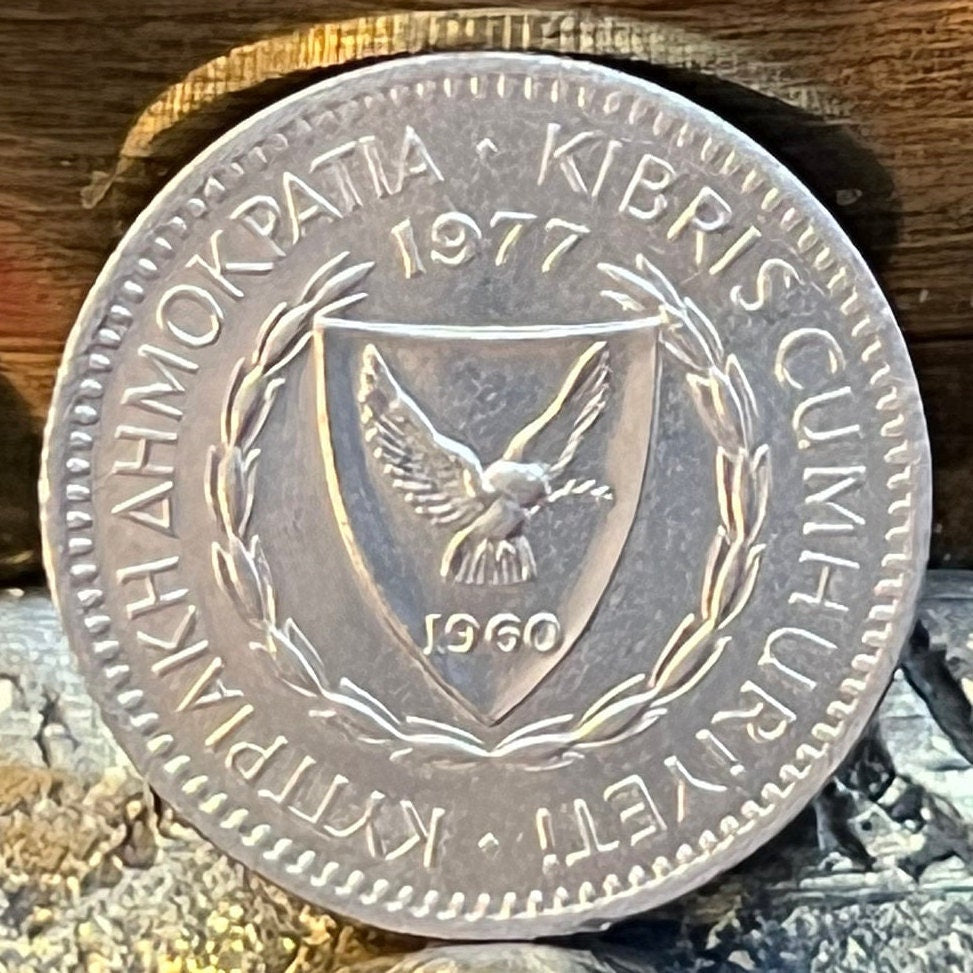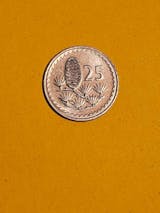elemintalshop
Cedar Cone & Dove with Olive Twig 25 Mils Cyprus Authentic Coin Money for Jewelry and Craft Making (Gilgamesh) (1960) (Pine Cone)
Cedar Cone & Dove with Olive Twig 25 Mils Cyprus Authentic Coin Money for Jewelry and Craft Making (Gilgamesh) (1960) (Pine Cone)
Couldn't load pickup availability
Cedar Cone & Dove with Olive Twig 25 Mils Cyprus Authentic Coin Money for Jewelry and Craft Making (Gilgamesh) (1960) (Pine Cone)
Reverse: Cedar of Lebanon pinecone, denomination at left
Lettering: 25
Obverse: The coat of arms of the Republic (A dove holding an olive twig and the independence year 1960), laurel twigs around, tha date above and in the circle inscription: ΚΥΠΡΙΑΚΗ ΔΗΜΟΚΡΑΤΙΑ · KIBRIS CUMHURİYETİ ·
Lettering: ΚΥΠΡΙΑΚΗ ΔΗΜΟΚΡΑΤΙΑ · KIBRIS CUMHURİYETİ ·
1960
Translation: REPUBLIC OF CYPRUS · REPUBLIC OF CYPRUS ·
1960
Edge: Reeded
Features
Issuer Cyprus
Period Republic (1960-date)
Type Standard circulation coin
Years 1963-1982
Value 25 Mils (0.025)
Currency Pound (decimalized, 1955-1982)
Composition Copper-nickel
Weight 2.83 g
Diameter 19.41 mm
Thickness 1.3 mm
Shape Round
Technique Milled
Orientation Medal alignment ↑↑
Demonetized Yes
Number N# 3605
References KM# 40
Wikipedia:
History and symbolism
In the Epic of Gilgamesh, one of the earliest great works of literature, the Sumerian hero Gilgamesh and his friend Enkidu travel to the legendary Cedar Forest to kill its guardian and cut down its trees. While early versions of the story place the forest in Iran, later Babylonian accounts of the story place the Cedar Forest in the Lebanon.
The Lebanon cedar is mentioned several times in the Bible. Hebrew priests were ordered by Moses to use the bark of the Lebanon cedar in the treatment of leprosy. Solomon also procured cedar timber to build the Temple in Jerusalem. The Hebrew prophet Isaiah used the Lebanon cedar (together with "oaks of Bashan", "all the high mountains" and "every high tower") as examples of loftiness as a metaphor for the pride of the world and in Psalm 92:12 it says "The righteous shall flourish like the palm tree: he shall grow like a cedar in Lebanon".
*******
Wikipedia:
Cedrus brevifolia, the Cyprus cedar, is a species of conifer in the genus Cedrus. It is native to the Troödos Mountains of central Cyprus. It grows in the Cedar Valley in Pafos State Forest. It is often considered to be a synonym of Cedrus libani (cedar of Lebanon)
Cedrus libani, the cedar of Lebanon or Lebanese cedar (Arabic: أرز لبناني, romanized: ʾarz Lubnāniyy), is a species of tree in the pine family, native to the mountains of the Eastern Mediterranean basin. It is a large evergreen conifer that has great religious and historical significance in the cultures of the Middle East, and is referenced many times in the literature of ancient civilisations. It is the national emblem of Lebanon and is widely used as an ornamental tree in parks and gardens.
Cones
Cedrus libani produces cones beginning at around the age of 40. Its cones are borne in autumn, the male cones appear in early September and the female ones in late September. Male cones occur at the ends of the short shoots; they are solitary and erect about 4 to 5 cm (1.6 to 2.0 in) long and mature from a pale green to a pale brown color. The female seed cones also grow at the terminal ends of short shoots. The young seed cones are resinous, sessile, and pale green; they require 17 to 18 months after pollination to mature. The mature, woody cones are 8 to 12 cm (3.1 to 4.7 in) long and 3 to 6 cm (1.2 to 2.4 in) wide; they are scaly, resinous, ovoid or barrel-shaped, and gray-brown in color. Mature cones open from top to bottom, they disintegrate and lose their seed scales, releasing the seeds until only the cone rachis remains attached to the branches.
*******
Wikipedia:
The symbolism of the dove in Christianity is first found in the Old Testament Book of Genesis in the story of Noah's Ark, “And the dove came in to him at eventide; and, lo, in her mouth an olive-leaf plucked off: so Noah knew that the waters were abated from off the earth.” Genesis 8:11 And, also, in the New Testament Gospels of Matthew and Luke, both passages describe after the baptism of Jesus, respectively, as follows, “And Jesus when he was baptized, went up straightway from the water: and lo, the heavens were opened unto him, and he saw the Spirit of God descending as a dove, and coming upon him.” Matthew 3:16 and, “And the Holy Spirit descended on him in bodily form like a dove. And a voice came from heaven: “You are my Son, whom I love; with you I am well pleased.” Luke 3:22 The Holy Spirit descending on Jesus and appearing in the bodily form of a dove is mentioned in the other two Gospels as well (see Mark 1:10 and John 1:32).
The use of a dove and olive branch as a symbol of peace originated with the early Christians, who portrayed the act of baptism accompanied by a dove holding an olive branch in its beak and also used the image on their sepulchres.
Christians derived the symbol of the dove and olive branch from Greek thought, including its use of the symbol of the olive branch, and the story of Noah and the Flood. Although Jews never used the dove as a symbol of peace, it acquired that meaning among early Christians, confirmed by St Augustine of Hippo in his book On Christian Doctrine and became well established.
In Christian Iconography, a dove also symbolizes the Holy Spirit, in reference to Matthew 3:16 and Luke 3:22 where the Holy Spirit is compared to a dove at the Baptism of Jesus.[Mt 3:16]
The early Christians in Rome incorporated into their funerary art the image of a dove carrying an olive branch, often accompanied by the word "Peace". It seems that they derived this image from the simile in the Gospels, combining it with the symbol of the olive branch, which had been used to represent peace by the Greeks and Romans. The dove and olive branch also appeared in Christian images of Noah's ark. The fourth century Vulgate translated the Hebrew alay zayit (leaf of olive) in Genesis 8:11 as Latin ramum olivae (branch of olive). By the fifth century, Augustine of Hippo wrote in On Christian Doctrine that "perpetual peace is indicated by the olive branch (oleae ramusculo) which the dove brought with it when it returned to the ark".
In the earliest Christian art, the dove represented the peace of the soul rather than civil peace, but from the third century it began to appear in depictions of conflict in the Old Testament, such as Noah and the Ark, and in the Apocrypha, such as Daniel and the lions, the three young men in the furnace, and Susannah and the Elders.
Before the Peace of Constantine (313 AD), in which Rome ceased its persecution of Christians following Constantine's conversion, Noah was normally shown in an attitude of prayer, a dove with an olive branch flying toward him or alighting on his outstretched hand. According to Graydon Snyder, "The Noah story afforded the early Christian community an opportunity to express piety and peace in a vessel that withstood the threatening environment" of Roman persecution. According to Ludwig Budde and Pierre Prigent, the dove referred to the descending of the Holy Spirit rather than the peace associated with Noah. After the Peace of Constantine, when persecution ceased, Noah appeared less frequently in Christian art.
Medieval illuminated manuscripts, such as the Holkham Bible, showed the dove returning to Noah with a branch. Wycliffe's Bible, which translated the Vulgate into English in the 14th century, uses "a braunche of olyue tre with greene leeuys" ("a branch of olive tree with green leaves") in Gen. 8:11. In the Middle Ages, some Jewish illuminated manuscripts also showed Noah's dove with an olive branch, for example, the Golden Haggadah (about 1420).
Share










Satisfied buyer here! This lovely little coin is in fantastic condition. Recommended seller!
I thoroughly enjoy walking in the woods looking at trees. This coin will be a reminder of how much I love looking at trees!
Items were exactly as advertised. I was happy with the product and prompt delivery. I would use this seller again.
Fantastic
5 stars review from Dave










